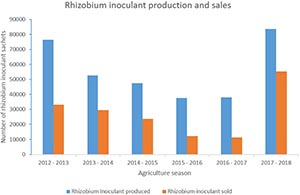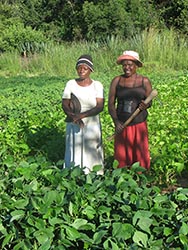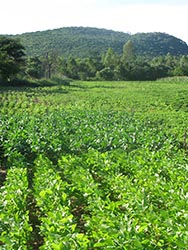Zimbabwe has traditionally grown soyabean with inoculation since the 1960’s, particularly in the large scale commercial farms. The country has a government run inoculant production facility at the Soil Productivity Research Lab (SPRL), producing inoculant for a wide range of legumes. Soyabean is the main crop for which rhizobium inoculant is produced, accounting for more than 90 % of inoculants sold. The Soil Productivity Research Laboratory received support from N2Africa in 2012 for rhizobium research, production and development and to train personnel in rhizobiology.
|
The SPRL produces a rhizobia inoculant on a bagasse carrier medium. For soyabean, one sachet of rhizobium inoculant is sufficient for 1 ha or 80 to 100 kg of seed. However, many smallholder farmers use the sachet on less than one ha because they may grow only that much soyabean as soyabean is a secondary crop, competing for land and financial resources with maize and other crops. In the past five years, rhizobium inoculant use has peaked at about 40,000 sachets per year (Fig. 1). In response to this, the rhizobium inoculant production target at SPRL was set at 40,000 sachets in 2015 and 2016. In those years, inoculant use fell to just over 12,000 (2015) and just over 11,000 (2016). This was a result of several factors, including the failure in those years to match the timing of demand with supply as well as the El Nino induced drought. |

|
 |
Left: Inoculated in foreground - uninoculated behind the farmers Right: Soyabean - inoculation trials |
 |
In 2017, soyabean was introduced to two government input schemes, a contract farming scheme and a smallholder development support scheme. The target for the contract farming programme, was 60,000 ha of soyabean under both smallholder and commercial farming systems. In response to this, SPRL set the target for rhizobium inoculant production to 80,000 sachets, sufficient for the 60,000 ha, as well as non-contract farming growers, SPRL met this target and 55,255 standard sachets were sold. The second programme was targeting smallholder farmers and a “special” 30 g packaging was specifically made to match farmer requirements. Despite the quick turnaround time and high inoculant demand from the 2 government sponsored schemes SPRL managed to sell 63,958 ha worth of rhizobium inoculant with the smaller packaging alone. Soyabean inoculant is more than 50 years old in Zimbabwe and almost forty years old in the smallholder communities, and yet still not very well known in smallholder communities. These government programmes are a great opportunity to introduce soyabean production and inoculant to many smallholder communities and thereby stimulate demand in the future.
The legume inoculant factory is operating below capacity since the majority inoculant production is targeted at rainy season crop production. The SPRL manages to meet the inoculant demand. There is a need to stimulate more demand so that more farmers can benefit from inoculant use; and to develop more efficient inoculant distribution to ensure access by all farmers throughout the country. SPRL intends to boost all the programmes to popularise rhizobia inoculant with media advertisements, more decentralisation and closer coordination of the rhizobium sales.
Mazvita Chiduwa, SPRL, Zimbabwe
